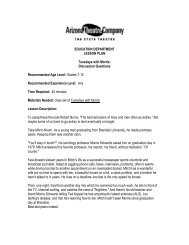Clybourne Park (PDF) - Arizona Theatre Company
Clybourne Park (PDF) - Arizona Theatre Company
Clybourne Park (PDF) - Arizona Theatre Company
- No tags were found...
Create successful ePaper yourself
Turn your PDF publications into a flip-book with our unique Google optimized e-Paper software.
TABLE OF CONTENTS.ABOUT ATC . 1INTRODUCTION TO THE PLAY. 2SYNOPSIS. 2MEET THE CREATORS. 3MEET THE CHARACTERS. 4A RAISIN IN THE SUN: INSPIRING CLYBOURNE PARK. 5HANSBERRY V. LEE: INSPIRING A RAISIN IN THE SUN. 6BRUCE NORRIS: REFLECTIONS ON CLYBOURNE PARK 7IDEAS IN CLYBOURNE PARK . 8HISTORICAL CONTEXT: WORLD EVENTS OF THE 1950s AND 2000s. 9CRITICAL EVENTS TOWARD CIVIL RIGHTS IN THE U.S. . 11DISCUSSION QUESTIONS AND ACTIVITIES . 13<strong>Clybourne</strong> <strong>Park</strong> Play Guide written and compiled by Katherine Monberg, ATC Literary Assistant. Discussion questions and activitiesprovided by April Jackson, Education Manager, Amber Tibbitts and Bryanna Patrick, Education Associates.Support for ATC’s education and community programming has been provided by:APS<strong>Arizona</strong> Commission on the ArtsBank of America FoundationBlue Cross Blue Shield <strong>Arizona</strong>City Of GlendaleCommunity Foundation for Southern <strong>Arizona</strong>Cox CharitiesDowntown Tucson PartnershipEnterprise Holdings FoundationFord Motor <strong>Company</strong> FundFreeport-McMoRan Copper & Gold FoundationJPMorgan ChaseJohn and Helen Murphy FoundationNational Endowment for the ArtsPhoenix Office of Arts and CulturePICOR Charitable FoundationRosemont CopperStonewall FoundationTargetThe Boeing <strong>Company</strong>The Donald Pitt Family FoundationThe Johnson Family Foundation, Inc.The Lovell FoundationThe Marshall FoundationThe Maurice and Meta GrossFoundationThe Max and Victoria DreyfusFoundationThe Stocker FoundationThe William L. and Ruth T. PendletonMemorial FundTucson Medical CenterTucson Pima Arts CouncilWells Fargo
ABOUT ATC<strong>Arizona</strong> <strong>Theatre</strong> <strong>Company</strong> is a professional, not-for-profit theatrecompany. This means all of our artists, administrators andproduction staff are paid professionals, and the income we receivefrom ticket sales and contributions goes right back into our budgetto create our work, rather than to any particular person as a profit.The Temple of Music and Art, the home of ATC shows in downtown Tucson.Each season, ATC employs hundreds of actors, directors anddesigners from all over the country to create the work you see onstage. In addition, ATC currently employs about 100 staff membersin our production shops and administrative offices in Tucson andPhoenix during our season. Among these people are carpenters,painters, marketing professionals, fundraisers, stage directors,computer specialists, sound and light board operators, tailors,costume designers, box office agents, stage crew – the list isendless – representing an amazing range of talents and skills.We are also supported by a Board of Trustees, a group of business and community leaders who volunteer their time and expertise toassist the theatre in financial and legal matters, advise in marketing and fundraising, and help represent the theatre in our community.Roughly 150,000 people attend our shows every year, and several thousands of those people support us with charitable contributionsin addition to purchasing their tickets. Businesses large and small, private foundations and the city and state governments also supportour work financially.All of this is in support of our vision and mission:Our vision is to touch lives through the power of theatre.Our mission is to create professional theatre that continuallystrives to reach new levels of artistic excellence and that resonateslocally, in the state of <strong>Arizona</strong> and throughout the nation. In orderto fulfill our mission, the theatre produces a broad repertoireranging from classics to new works, engages artists of the highestcaliber, and is committed to assuring access to the broadestspectrum of citizens.The Herberger Theater Center, ATC’s performance venue in downtown Phoenix.1
INTRODUCTION TO THE PLAYActor Anthony Fleming III, who plays Albert /Kevin in ATC’s production of <strong>Clybourne</strong> <strong>Park</strong>.Actor Lee E. Ernst, who plays Russ / Danin ATC’s production of <strong>Clybourne</strong> <strong>Park</strong>.<strong>Clybourne</strong> <strong>Park</strong>, by Bruce Norris, Directed by Mark ClementsActress Jenny McKnight, who playsBev / Kathy in ATC’s production of<strong>Clybourne</strong> <strong>Park</strong>.Actress Marti Gobel, who playsFrancine / Lena in ATC’s productionof <strong>Clybourne</strong> <strong>Park</strong>.Home is where the heart – and history – is. Jokes fly and hidden agendas unfold as two vastly different generations of characters tip-toe thedelicate dance of social politics. Pitting race against real estate, two seminal events – 50 years apart – are at the crux of the conflict in the sameNorth Chicago house. This rich and lightning quick 2011 Pulitzer Prize-winning comedy is every bit as provocative as it is entertaining as it cleverlyspins the events of A Raisin in the Sun into an unforgettable new story about race and real estate in America.SYNOPSIS Please note: This synopsis contains spoilers.ACT I In 1959, Russ Stoller sits in his house in <strong>Clybourne</strong> <strong>Park</strong>, a neighborhood of Chicago. In two days, Russ and his wife, Bev, are movingto Glen Meadow, a suburb outside of the city, where Russ will begin work at his new office. Bev and their African-American housemaid,Francine, pack some final items. Since the death of Russ and Bev’s son, Kenneth, a Korean War veteran, the home (and the neighborhoodas a whole) has been a source of pain for the couple. Bev hopes the move will be a fresh start. Jim, their minister, arrives to console Russ,whose anger and hopelessness worry his wife. Russ, however, tells the minister to leave him alone. Before Jim can leave, Albert, Francine’shusband, arrives to collect her. He volunteers to help with a heavy trunk that needs to be carried downstairs. Karl Lindner, a representativeof the neighborhood community association, arrives with his wife, Betsy. He expresses his concern that the Stollers sold their house to anAfrican-American family. Jim brings Francine into the conversation, asking her whether her black family would be happy moving into a white neighborhood,but Russ declares the conversation over: the sale of the house is final. Despite Karl’s arguments, Russ refuses to budge. Claiminghe has a responsibility to protect the community, Karl threatens to scare the buyers away by telling them why they are getting such a gooddeal on the property – because Kenneth committed suicide in the house. Russ thunders that he does not care about the community thatturned its back on Kenneth when he returned from the war a broken man, and then treated the family like “the plague” after their son’ssuicide. The situation turns violent, and everyone leaves. Russ tells Bev that he will bury the trunk in the backyard.Actor Grant Goodman who plays Jim / Tomin ATC’s production of <strong>Clybourne</strong> <strong>Park</strong>.ACT IIActor Gerard Neugent, who plays Karl/Stevein ATC’s production of <strong>Clybourne</strong> <strong>Park</strong>.In 2009, Steve and his pregnant wife, Lindsey, meet with their lawyer, Kathy (the daughter of Betsy and Karl), in the same <strong>Clybourne</strong> <strong>Park</strong>house where Russ and Bev once lived. They are joined by Kevin and his wife, Lena (the great-niece of Lena “Mama” Younger from LorraineHansberry’s A Raisin in the Sun), and Tom from the neighborhood Property Owners Association, to discuss a petition that protests Steve andLindsey’s proposed renovation of the house. Steve and Lindsey are moving into <strong>Clybourne</strong> <strong>Park</strong> from Glen Meadow and plan to build a largerhouse on the property. The Property Owners Association, contacted by a concerned Lena and Kevin, wants to ensure that the new homeis consistent with the “historically significant” neighborhood’s aesthetic. While the group attempts to wade through the legalese, they are2Actress Greta Wohlrabe, who playsBetsy / Lindsey in ATC’s productionof <strong>Clybourne</strong> <strong>Park</strong>.Actor Taylor Rascher, who playsKenneth in ATC’s productionof <strong>Clybourne</strong> <strong>Park</strong>.
interrupted both by cell phone calls and Dan, a handyman who is working on digging up a dead crepe myrtle tree in the backyard. Lenafinally loses her patience, feeling that she is the only one taking the matter at hand seriously. She takes great pride in <strong>Clybourne</strong> <strong>Park</strong>’shistory of African-American struggle. This house in particular has personal resonance for her, as her great-aunt lived here and was the firstperson of color to move into the neighborhood. A heated argument about racism, reverse racism, gentrification, sexism, and marginalizationensues, during which Dan enters dragging a trunk he has unearthed beneath the tree. The squabble succeeds in offending everyone, andthey all depart. Dan manages to get the trunk open. He finds a letter written by Kenneth to his parents. As Dan reads the letter, 2009dissolves into the day that Kenneth committed suicide. Kenneth writes a letter to his parents as Francine arrives to start the housework;his mother, who overslept, comes down from bed to reassure her son that the world is going to change for the better.– Written by Lena Hoffman, reprinted with permission from Milwaukee Repertory Theater.MEET THE CREATORSBruce NorrisBRUCE NORRIS (Playwright – <strong>Clybourne</strong> <strong>Park</strong>) is a 1982 graduate of Northwestern University with adegree in theater. Norris began his career as an actor, appearing in productions at Victory Gardens andthe Goodman, as well as on Broadway in Neil Simon’s Biloxi Blues. He also appeared in film, playingthe stuttering teacher in 1999’s The Sixth Sense. In the late 1990s, Norris committed himself toplaywriting full time, moving from Chicago to New York. In addition to <strong>Clybourne</strong> <strong>Park</strong>, Norris has writtenThe Infidel (2000), Purple Heart (2002), We All Went Down to Amsterdam (2003), The Pain and the Itch(2004), and The Unmentionables (2006), all of which had their premieres at Chicago’s Steppenwolf<strong>Theatre</strong>. His newest play, A Parallelogram, premiered there in July 2011. His work has also been seenat Playwrights Horizons (New York), Lookingglass <strong>Theatre</strong> (Chicago), Philadelphia <strong>Theatre</strong> <strong>Company</strong>,Woolly Mammoth <strong>Theatre</strong> (Washington, D.C.), Staatstheater Mainz (Germany), and The GalwayFestival (Ireland), among others. He is the recipient of the Steinberg Playwright Award (2009), TheWhiting Foundation Prize for Drama (2006), as well as two Joseph Jefferson Awards (Chicago) forBest New Work. As an actor he can be seen in the films A Civil Action, The Sixth Sense, and therecent All Good Things.– Reprinted with permission from Milwaukee Repertory Theater.LORRAINE HANSBERRY (Playwright – A Raisin in the Sun) was born on May 19, 1930, the youngestof four children. Her father, Carl, worked as a real estate broker and her mother as a schoolteacher.In 1938, the Hansberry family moved to the Washington <strong>Park</strong> Subdivision, an all-white neighborhoodLorraine Hansberry, 1959.in Chicago, and was attacked, often violently, by their new neighbors for their refusal to acquiesce tothe residential covenant that forbade African-Americans from taking up residence there. The neighborhood’s legal efforts to force theHansberrys to relocate eventually made its way to the Supreme Court as Hansberry v. Lee, which ruled in favor of the Hansberry family.Hansberry attended the University of Wisconsin-Madison, where she originally intended to become a painter. After changing her majorto writing, she withdrew from the university in 1950 and moved to New York City to pursue her writing career.Once in New York, Hansberry began taking writing classes at the New School for Social Research and worked as a writer and editor forPaul Robeson’s progressive black newspaper Freedom. In 1953, Hansberry left her job at the paper and married Robert B. Nemiroff, aJewish songwriter, whom she had met on a picket line protesting discrimination at NYU. She worked as a waitress and cashier whilewriting in her spare time, and by 1956 had left her jobs to devote her full attention to her writing. During this period, she authored theplay Crystal Stair, later renamed A Raisin in the Sun, from a line in a Langston Hughes poem. The play opened on Broadway in 1959 tohuge success, and was followed by a film version starring Sidney Poitier in 1961. Her success was slightly shadowed by bad publicitythat forced her family to leave Chicago for Los Angeles, and by marital problems that led her to obtain a quiet divorce in Mexico in 1964.3
Hansberry’s second play, The Sign in Sidney Brustein’s Window, was completed in 1964, and remains her only other drama to be producedonstage during her lifetime. While the play was in production, Hansberry became increasingly ill, spending more and more time inhospitals, and she died of pancreatic cancer on January 12, 1965, at the young age of 34 – passing away on the same night that hersecond production closed.Several of Hansberry’s writings continued to be developed and adapted after her death by her former husband, Robert Neminoff, actingas her literary executor. To Be Young, Gifted and Black, adapted from many of her writings, was produced Off-Broadway in 1969. LesBlancs, a drama set in Africa and originally drafted by Hansberry as early as 1960, was further developed and presented in New YorkCity in 1970, touring nationally for the next two years. Finally, Neminoff and Charlotte Zaltzberg adapted Hansberry’s first play into amusical, Raisin, which won the 1973 Tony Award for Best Musical, and was revived in 1981.Though the years of her life span only a short time, the lasting impact of Lorraine Hansberry’s voice continues to resonate as a part ofthe base that has formed American drama as we recognize it today. Her work in civil rights activism and anti-discrimination discoursein America continues to impact the scholars and audiences of the present, reaching us even now through the pages of Bruce Norris’s<strong>Clybourne</strong> <strong>Park</strong>.MEET THE CHARACTERSCostume rendering of Russ by Costume DesignerRachel Healy.Costume rendering of Bev by Costume DesignerRachel Healy.Costume rendering of Kevin by Costume DesignerRachel Healy.ACTOR ACT I ACT IILee E. Ernst Russ, owner of the house for sale Dan, a handymanJenny McKnight Bev, married to Russ Kathy, Steve and Lindsey’s lawyerMarti Gobel Francine, Russ and Bev’s maid Lena, married to KevinAnthony Fleming III Albert, married to Francine Kevin, married to LenaGrant Goodman Jim, Russ and Bev’s minister Tom, neighborhood association representativeGerard Neugent Karl, neighborhood association representative Steve, buying the house, married to LindseyGreta Wohlrabe Betsy, married to Karl Lindsey, buying the house, married to SteveTaylor RascherKenneth, the son of Bev and Russ4
A RAISIN IN THE SUN: INSPIRING CLYBOURNE PARK<strong>Clybourne</strong> <strong>Park</strong> is a response to one of the most celebrated plays in American drama: A Raisin inthe Sun. Playwright Bruce Norris directly connects the two plays. In A Raisin in the Sun, the Youngerfamily buys a house in the <strong>Clybourne</strong> <strong>Park</strong> neighborhood; <strong>Clybourne</strong> <strong>Park</strong> takes place in that house.When Lorraine Hansberry’s A Raisin in the Sun opened on Broadway in 1959, it became the first playby an African-American woman to do so. The play won the Pulitzer Prize for Drama, the New YorkDrama Critics Circle Award for Best New Play, and was nominated for four Tony Awards. On the25th anniversary of the play, The New York Times called A Raisin in the Sun the play that “changedAmerican theater forever.”Costume rendering of Lena from <strong>Clybourne</strong> <strong>Park</strong>,a descendant of Lena Younger from A Raisin in the Sun.Credit: Rachel HealyIn A Raisin in the Sun, five family members share a small, three-room apartment – Lena (Mama)Younger, her daughter Beneatha, her son Walter Lee, Walter’s wife Ruth, and their son Travis. WhenMama receives a life insurance check after her husband’s death, each member of the family arguesit should be used to further their own individual dreams. Eventually, Mama decides to use the moneyas a down payment for a house with enough room for the entire family. With their own house, shesees a bright future for her family.The house is located in <strong>Clybourne</strong> <strong>Park</strong>, an entirely white neighborhood. When the residents of<strong>Clybourne</strong> <strong>Park</strong> learn that an African-American family bought the house, they send Karl Lindner,a representative from the <strong>Clybourne</strong> <strong>Park</strong> Improvement Association, to visit the family. He offersthem money in exchange for not moving into the neighborhood. However, Lindner fails to convincethe family, and, refusing the money, the optimistic Youngers move to <strong>Clybourne</strong> <strong>Park</strong>.In the original New York Times review of the play, Brook Atkinson noted:Costume rendering of Karl by costume designerRachel Healy; Karl also appears in A Raisin in the Sun.“In A Raisin in the Sun…Lorraine Hansberry touches on some serious problems.No doubt, her feelings about them are as strong as anyone’s. But she has not tipped herplay to prove one thing or another. The play is honest. She has told the inner as well asthe outer truth about a Negro family in the South Side of Chicago at the present time…That is Miss Hansberry’s personal contribution to an explosive situation in whichsimple honesty is the most difficult thing in the world. And also the most illuminating.”Lorraine Hansberry believed in finding the universal through the specific, saying, “one of the most sound ideas in dramatic writing isthat, in order to create the universal, you must pay very great attention to the specific.” In a 1961 interview on A Raisin in the Sun,Hansberry elaborated:“I don’t think there is anything more universal in the world than man’s oppression of man. This is what most greatdramas have been about, no matter what the device of telling it is. We tend to think, because it is so immediate withus in the United States, that this is a unique human question where white people do not like black people…but thefact of the matter is wherever there are men, there are oppressed people and…to the extent that my work is asuccessful piece of drama it makes the reality of this oppression true.”Since its premiere in 1959, the play has been translated into thirty languages. The play became a film in 1961, starring Sidney Poitierand most of the original Broadway cast. Since then, the play has also been made into two made-for-TV movies, once in 1989 starringDanny Glover, and again in 2008, starring Sean Combs.– Written by Lena Hoffmann, reprinted with permission from Milwaukee Repertory Theater.5
HANSBERRY V. LEE: INSPIRING A RAISIN IN THE SUNHansberry’s play drew inspiration from her own childhood growing up onChicago’s South Side and moving into an entirely white neighborhoodat a young age. Many neighborhoods had racially restrictive covenants,agreements written into the property deeds binding the owners to notsell or rent their property to specific minority groups.In 1937, Lorraine’s father, Carl, a realtor active in the NAACP, bought ahouse in Washington <strong>Park</strong>, a “restricted” all-white neighborhood ofWoodlawn. Like most of Chicago, the neighborhood had estate covenantsprohibiting sales to African-Americans. The specific covenant in Washington<strong>Park</strong> stated, “no part of said premises shall in no manner be used or occupiedby a negro or negroes.” The covenant did specify that African-Americanscould be chauffeurs or house servants, as long as they did not own theHeadline from The Chicago Defender in 1940 announcing the verdict of Hansberry v. Lee.house. Anyone who signed the covenant covering the same land in theneighborhood could enforce these covenants. The Kenwood ImprovementAssociation filed a mandatory injunction for the family to vacate their home. With support of the NAACP, Carl Hansberry challenged theinjunction and took the case all the way to the Supreme Court in a case bearing the Hansberry family name. Hansberry’s lawyers wonthe case when the court rejected the specific covenant impacting the Hansberry family, but did not achieve a ruling on the constitutionalityof restrictive residential covenants. The Supreme Court eventually ruled racially restrictive covenants a violation of the fourteenthamendment eight years later in Shelley vs. Kraemer when an African-American couple purchased a home in a restricted neighborhoodin St. Louis.– Written by Lena Hoffmann, reprinted with permission from Milwaukee Repertory Theater.“My father was typical of a generation of Negroes who believed that the “American way” could successfully be made to work to democratizethe United States. Thus, twenty-five years ago, he spent a small personal fortune, his considerable talents, and many years of his life fighting,in association with NAACP attorneys, Chicago’s “restrictive covenants” in one of this nation’s ugliest ghettos.The fight also required our family to occupy disputed property in a hellishly hostile “white neighborhood” in which, literally, howling mobssurrounded our house. One of their missiles almost took the life of the then eight-year-old signer of this letter. My memories of this “correct”way of fighting white supremacy in America include being spat at, cursed and pummeled in the daily trek to and from school. And I alsoremember my desperate and courageous mother, patrolling our house all night with a loaded German Luger, doggedly guarding her fourchildren, while my father fought the respectable part of the battle in the Washington court.”– Lorraine Hansberry, letter to the editor, New York Times, April 23, 19646
BRUCE NORRIS: REFLECTIONS ON CLYBOURNE PARK“I saw A Raisin in the Sun as a film in probably seventh grade. Interestingly our Social Studies teacher was showing it to a classof all white students who lived in an independent school district, the boundaries of which had been formed specifically toprevent our being integrated into the Houston school district and being bused to other schools with black students.So I don’t know whether our teacher was just obtuse, or crafty and subversive, but she was showing us a movie that basically in theend – because Karl doesn’t come in until the second act – is really pointing a finger at us and saying we are those people. So I watch itat twelve years old and I could realize even then that I’m Karl Lindner. To see that when you’re a kid and to realize that you’re the villainhas an impact.For years I thought I wanted to play Karl Lindner but then as time went on I thought it’s really an interesting story to think about theconversation that was going on in the white community about the Younger family moving into <strong>Clybourne</strong> <strong>Park</strong>. It percolated for manyyears and that’s how I ended up writing this play.”– Bruce Norris in an interview with Rebecca Rugg, Artistic Producer at Steppenwolf <strong>Theatre</strong> <strong>Company</strong>.“It was very important to me to depict the people in 1959 as people with good intentions. They’re not racists in the KKK way –they’re people who think that they’re doing the right thing to protect their neighborhood and their children and their real estatevalues. But that’s a form of self-interest that has as its unfortunate byproduct a really racist outcome.”– Bruce Norris in an interview with Kurt Andersen at Studio 360.“Audiences have this sort of childlike need to identify who their hero is in a story and to root for them and get behind them, andone of my favorite things to do as a writer is to confound that impulse.”– Bruce Norris in an interview with Kurt Andersen at Studio 360.“Pretty much every big city has some version of this. Even where I grew up in Houston, it’s a similar thing. There is no actual<strong>Clybourne</strong> <strong>Park</strong> in Chicago. Or, to be strictly accurate, there is a playground called Clybourn [sic] <strong>Park</strong> on Clybourn Avenue, butthere is no neighborhood called <strong>Clybourne</strong> [or Clybourn] <strong>Park</strong>. That is something Lorraine Hansberry made up. If you want to have anexample of the kind of neighborhood we’re talking about, it would be Wicker <strong>Park</strong> or Ukrainian Village in Chicago. More Wicker <strong>Park</strong>.Wicker <strong>Park</strong> is a neighborhood that was mostly Latino for about 25 years, and it’s very close to where Cabrini-Green used to be.Cabrini-Green was a big, dangerous housing project, which is about three or four blocks from where Steppenwolf <strong>Theatre</strong> is now.”– Bruce Norris speaking with Beatrice Basso of American Conservatory Theater.7
IDEAS IN CLYBOURNE PARK“<strong>Clybourne</strong> <strong>Park</strong> confronts huge subjects: gentrification, race relations, and politicalcorrectness, among others. It’s hard for any play to tackle any one of those things, butto take on so many and to take them on so brilliantly and fluidly without lecturing theaudience – while at the same time being hilariously funny – is an extraordinary feat.”– Mark Clements, Director of ATC / Milwaukee Rep co-production of <strong>Clybourne</strong> <strong>Park</strong>.Scenic model for Act I of <strong>Clybourne</strong> <strong>Park</strong> by Scenic Designer Todd Edward Ivins.COMMUNITY<strong>Clybourne</strong> <strong>Park</strong> asks the question, what makes a community? How do peoplejoin together with a common purpose of living together and supporting eachother? Is that even possible? In Act I, the character of Karl Lindner says“fitting into a community is really what it all comes down to.”GENTRIFICATIONGentrification is defined by the Merriam-Webster Dictionary as“the process of renewal and rebuilding accompanying the influx ofmiddle-class or affluent people into deteriorating areas that often displaces poorer residents.”“I just have a lot of respect for the people who wentthrough those experiences and still managed to carve outa life for themselves and create a community despite awhole lot of obstacles.” – Lena, Act II“What, ya mean the community where every time I go fora haircut, where they all sit and stare like the goddamngrim reaper walked in the barber shop door? Thatcommunity? Where Bev stops at Gelman’s for a quart ofmilk and they look at her like she’s got the goddamnplague? That the community I’m supposed to be lookingout for?” – Russ, Act ILena: Well, then they tore down the Sup’r Sav’r, so –Kevin: You know where the Whole Foods is?– Act II“That’s just a part of my history and my parents’ history –and honoring the connection to that history – and, no one,myself included, likes having to dictate what you canor can’t do with your own home, but there’s just a lot ofpride, and a lot of memories in these houses, and forsome of us, that connection still has value, if that makesany sense?” – Lena, Act IIThe second act of <strong>Clybourne</strong> <strong>Park</strong> tackles the polarizing debate surroundinggentrification. For some, gentrification means the revitalization ofinner city neighborhoods and the creation of new buildings in place ofvacant lots, new business selling an increased variety of goods, andimprovements to public works like sidewalks. However, to others,gentrification means the displacement of neighborhood residents due torising costs of living and property values. Does a neighborhood lose itshistorical identity when it becomes a more affluent area?RACIAL COMEDYIs America ready for racial comedy? Bruce Norris asks this question in<strong>Clybourne</strong> <strong>Park</strong>, sparing almost no group the punch line. Juxtaposing thecomedy of 1959 with 2009, Norris emphasizes America’s complicatedhistory with racial jokes.The 1960s marked a significant shift in racial comedy – a transition fromblatantly racist humor in the tradition of blackface minstrel shows, toracial humor in which exposing people’s prejudice is the punch line.Lena: (innocently) It was just a joke.Steve: Exactly!!Kathy: An extremely hostile joke.Lindsey: Directed at me.– Act II“It is funny. Yes it is. And and and and the reason it’s funny,is, is, is that it plays upon certain latent fears of – of – of –of white people.” – Steve, Act IIWhat is it that racial jokes do in contemporary society? Perhaps, as Emily Hoffman comments in American Conservatory Theater’s Wordson Plays, “laughter is a release valve, and in the context of tense race relations it can provide just the sort of breathing room needed towrestle with issues that would otherwise be too difficult or too uncomfortable to touch.”8
POLITICAL CORRECTNESSMuch of the comedy in <strong>Clybourne</strong> <strong>Park</strong> comes from the need to be politicallycorrect and what happens when characters cross that line. With comicmoments about race, gender, disability, sexuality, etc., Bruce Norrisreveals a world in which political correctness stifles conversation andyet protects people. Is political correctness necessary or does it inhibitpeople’s ability to talk to one another?“Sorry, don’t we say Negro, now?” – Jim, Act I“No. I’m sorry, but can we just come out and say what it iswe’re actually - ? Shouldn’t we maybe do that? Because ifthat’s what this is really about, then…Jesus, maybe weoughta save ourselves some time and and and just…saywhat it is we’re really saying instead of doing thiselaborate little dance around it.” – Steve, Act IIIn an interview with American Conservatory Theater, Bruce Norris commented, “theoretically [political correctness] is a step.So, now that we’ve all been very careful, you think that after some time goes by things will be normalized. We white people(because we are the oppressors) sit around going, “Is it time now? Has enough time elapsed?”…But of course that never happens,so white people feel resentful because we realize the past is going to hang around our necks like millstones forever. There is noend. Even if we gave reparation payments, still it wouldn’t be enough.”– Written by Lena Hoffmann, reprinted with permission from Milwaukee Repertory Theater.HISTORICAL CONTEXT: WORLD EVENTSOF THE 1950s AND 2000sEVENTS OF THE 1950s1950– First modern credit card created.– First organ transplant.– First “Peanuts” cartoon stripby Charles Schulz.– Senator Joseph McCarthybegins hunt for Communists.– Korean War begins.– The Rotary Club is founded.1951– Hydrogen bomb constructed.– South African citizens carry mandatory ID cards declaringtheir race.– Color television marketed in the U.S.Senator Joseph McCarthy.– Winston Churchill wins election to become Prime Ministerof UK.– President Truman signs peace treaty with Japan, officiallyending WWII.1952– Seat belts introduced in cars.– England’s King George VI dies.– Jacques Cousteau discoversa ship from ancient Greece.– The Great Smog of 1952.– Polio vaccine invented.– Chicago declared the secondlargest city in U.S.1953– Soviet leader Joseph Stalin dies.– DNA is discovered.– Mt. Everest climbed by Hillaryand Norgay.– Julius and Ethel Rosenbergexecuted for espionage.– Queen Elizabeth II coronated (UK).Jacques Cousteau.Ethel and Julius Rosenberg, executed forespionage in 1953.9
1954– Cigarettes first declared to cause cancer.– Launch of first atomic submarine.– Racial segregation declared unconstitutional in U.S.1955– Emmett Till murdered inMississippi, providing onespark for the Civil RightsMovement.– Disneyland opens in California.– James Dean is killed in a caraccident.– McDonald’s is founded.– Rosa <strong>Park</strong>s refuses to give up her bus seat.– Warsaw Pact is signed.1956– Grace Kelly weds Prince Rainier III of Monaco.– Hungarian Revolution takes place.– Krushchev denounces Stalin.– Suez Crisis.– Velcro is invented.– TV remote control is invented.1957– Publication of The Cat in the Hat by Dr. Seuss.– European Economic Community formed.– Soviet Union launches the satellite Sputnik.1958– Boris Pasternak refuses NobelPrize for Literature for DoctorZhivago, under pressure to doso from the Communist Partyof the Soviet Union and theUnion of Soviet Writers.Emmett Till.Boris Pasternak in 1934 at the first Congress of theUnion of Soviet Writers.– Chinese leader Mao Zedonglaunches the “Great LeapForward.”– The Hope Diamond is donatedto the Smithsonian Institute.– NASA is founded.– LEGOs are created.1959– Fidel Castro becomes dictator of Cuba.– International treaty makes Antarctica a scientific preserve.– Nixon and Khrushchev engage in Kitchen Debate.– The Sound of Music opens on Broadway.– The Barbie Doll is created.– A Raisin in the Sun opens on Broadway and in London.EVENTS OF THE 2000s2000– Global stock market crash due to dotcom bubble.– Millennium bug proves to be a myth.2001– Terrorists fly hijacked passengerplanes into the WTC andPentagon.– President George W. Bushannounces War on Terror.– Enron scandal breaks.2003– US and UK lead forces in Afghanistan against the Taliban.2004– Chicago’s Millennium<strong>Park</strong> Opens.– A Raisin in the Sun revivedon Broadway.Mao Zedong.President George W. Bush.Millennium <strong>Park</strong> in Chicago.10
2005– Suicide bombers attack Londontransport.– Kyoto protocol on climatechange unsigned by U.S.– White Sox sweep theWorld Series.– Hurricane Katrina.2007Image of the damage done to New Orleans byHurricane Katrina in 2005.– Chicago wins right to represent U.S. in bid for 2016 Olympics.2008– Barack Obama electedPresident of the United States.– World Banking Crisis affectsmajor banks and mortgagelending.2009– Barack Obama wins NobelPeace Prize.– Earthquake in Haiti.Barack Obama, 44th President of the United States.CRITICAL EVENTS TOWARD CIVIL RIGHTS IN THE U.S.1863– Abraham Lincoln’sEmancipation Proclamationfrees the slaves in theUnited States.1896– The Supreme Court upholdssegregation with the “separatebut equal” verdict of Plessy v.Ferguson.Abraham Lincoln.1940– Lorraine Hansberry’s father,Carl, wins Supreme Courtverdict in Hansberry v. Lee,which prohibits a Chicagoneighborhood from barringAfrican-American tenantsand homeowners.1946Jackie Robinson.– Supreme Court eliminates segregation on public transportation.1909– NAACP is founded (National Association for the Advancementof Colored People).1918– The beginning of the Harlem Renaissance.1919– Race riots erupt throughout the U.S.1947– Jackie Robinson becomes the first African-American MajorLeague Baseball player.1948– U.S. Armed Forces integrated by an executive order fromPresident Truman.1949– Supreme Court declares segregated neighborhoodsunconstitutional.11
1954– Supreme Court overturns “separate but equal” doctrine inBrown v. Board of Education.1955– Rosa <strong>Park</strong>s arrested inMontgomery, AL, for refusalto give up her seat on a busto a white man, resulting ina bus boycott.1957– President Eisenhower sendsthe U.S. Army to protect the“Little Rock Nine” after thegovernor of Arkansas refusesto desegregate Little RockHigh School.1959– A Raisin in the Sun opens onBroadway.1962– James Meredith deniedadmission to the Universityof Mississippi, based on race.1963– Civil rights March onWashington, D.C.1964– Martin Luther King, Jr. winsNobel Peace Prize.– Race riots in Harlem.Rosa <strong>Park</strong>s’ mug shot, 1955.The Little Rock Nine with military escort to classat Little Rock High School, 1957.James Meredith, holding a headline about his ownenrollment at the University of Mississippi.Martin Luther King, Jr.1965– Malcolm X assassinated.– Voting Rights Bill passed.– Watts race riots in Los Angeles.1967– Black Power conference inNewark, NJ.– Race riots in Detroit, Cleveland, and Newark.1968– Civil Rights Act of 1968 criminalizes racial discriminationin housing.– Martin Luther King, Jr. assassinated.1969– First Afro-American and Black Studies programs instituted atAmerican universities.1972– Shirley Chisholm becomes thefirst major-party black candidatefor President of the UnitedStates, and the first womanto run for the Democraticpresidential nomination.1983– President Reagan signs legislation declaring Martin Luther King,Jr. Day the third Monday in January.– Alice Walker’s The Color Purple wins the Pulitzer Prize for Fiction.1992– Riots in Los Angeles after a jury acquits an L.A. police officerafter the videotaped beating of Rodney King.2008Malcolm X.Shirley Chisholm.– Barack Obama becomes the first African-American to be electedas President of the United States.12
DISCUSSION QUESTIONS AND ACTIVITIESDISCUSSION QUESTIONS1. Why would the playwright choose to double-cast this play? What effect does it have to see the actors from Act I playingdifferent characters 50 years later in Act II?2. In addition to seeing the same actors in each act, there are also several repeating themes and mirrored sections of dialoguebetween Act I and Act II, such as the examples listed below. What comment do you think the playwright is making by repeatingthese conversation topics?GeographyAct I: “Ulan Bator!...capitol of Mongolia.”Act II: “What’s the capitol of Morocco?”What significance do these seemingly irrelevant conversations about the world at large have, considering the play’s themes ofplace, history, and identity?ChildrenIn both acts, characters often use their children’s future as an argument in their favor. But are their decisions and actions reallyserving to aid their children’s futures?“You can’t live in a principle.”This line is repeated by two different characters 50 years apart. What is the importance of this line? Do you agree with thesentiment? Has the relevance of that sentiment changed over time?3. In Act II, the character of Steve says, “The history of America is the history of private property.” What do you think he means?Do you agree or disagree? How do the ideas of ownership and personal identity overlap in our current society?4. “There is power in making people uncomfortable. There is power in provoking.” Do characters in this play wield that powereffectively? Does the playwright? How does humor help us examine difficult and controversial issues? Does humor diminishthe impact of important conversations?5. At the end of Act II, Bev says, “…I really believe things are about to change for the better.” She says this in a flashback andso the last lines of the play actually precede the play’s action. Do you think things did change for the better, or is this theplaywright commenting on the irony of change?6. The set transitions from 1959 to 2009 in front of the audience during intermission. Would the effect have been the same if thattransition occurred out of sight of the audience? What comment, if any, does this make about the passage of time?13
ACTIVITIES FOR TEACHERS AND STUDENTS1. Bruce Norris’s <strong>Clybourne</strong> <strong>Park</strong> takes the characters and events from Lorraine Hansberry’s A Raisin in the Sun and creates thenext part of their story: Act I takes place in 1959 – contemporaneous with the events in Hansberry’s play – and Act II in 2009.Imagine the neighborhood of <strong>Clybourne</strong> <strong>Park</strong> in the year 2059. How would the area have changed? How would Americansociety have changed? Would conversations and opinions about race and ethnicity still be what they are today? Write anoutline for a hypothetical Act III of <strong>Clybourne</strong> <strong>Park</strong>. Include a description of the new characters and how they are related (ornot) to the characters we’ve met already.2. Characters in <strong>Clybourne</strong> <strong>Park</strong> “talk around” many sensitive subjects. Group your students into teams and see if they can gettheir teammates to guess words from the list below (a la games like Taboo or $10,000 Pyramid ) without using any part or formof the word itself:husband wife family househome suburb neighborhood racesegregation ghetto history culturehappiness time American Dream respectlove racism ignorance Negroprejudice stereotype poverty wealth3. Ask students to brainstorm a list of groups they feel a part of (racially, ethnically, geographically, socially, etc.). Then ask themto brainstorm a list of groups they don’t personally identify with; is there any overlap? Have them create a visual representationof their lists, paying attention to any overlap they might have discovered. These visuals could be diagrams or charts orillustrations and can be as abstract or concrete as students wish.14


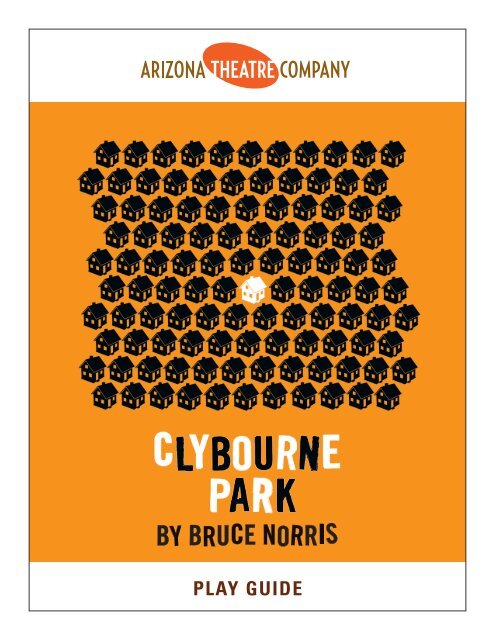
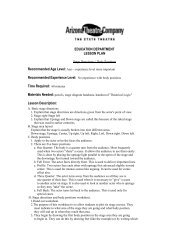



![Play Guide [356k PDF] - Arizona Theatre Company](https://img.yumpu.com/46218320/1/190x245/play-guide-356k-pdf-arizona-theatre-company.jpg?quality=85)
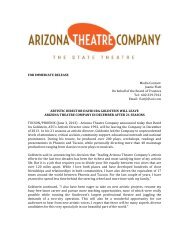
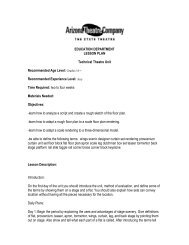
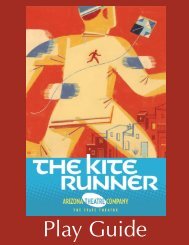
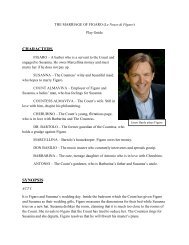
![[title of show] Arizona Theatre Company Play Guide 1](https://img.yumpu.com/24482689/1/190x245/title-of-show-arizona-theatre-company-play-guide-1.jpg?quality=85)
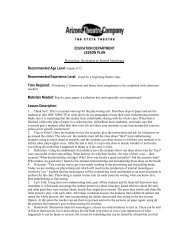
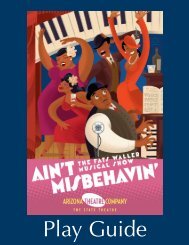
![Play Guide [1.2MB PDF] - Arizona Theatre Company](https://img.yumpu.com/11952176/1/190x245/play-guide-12mb-pdf-arizona-theatre-company.jpg?quality=85)
